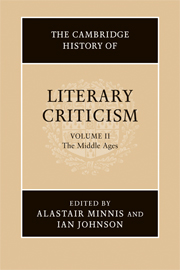Book contents
- Frontmatter
- Introduction
- I THE LIBERAL ARTS AND THE ARTS OF LATIN TEXTUALITY
- II THE STUDY OF CLASSICAL AUTHORS
- III TEXTUAL PSYCHOLOGIES: IMAGINATION, MEMORY, PLEASURE
- IV VERNACULAR CRITICAL TRADITIONS: THE EARLY MIDDLE AGES
- V VERNACULAR CRITICAL TRADITIONS: THE LATE MIDDLE AGES
- 14 Latin commentary tradition and vernacular literature
- 15 Vernacular literary consciousness c. 1100–c. 1500: French, German and English evidence
- 16 Occitan grammars and the art of troubadour poetry
- 17 Literary theory and polemic in Castile, c. 1200–c. 1500
- 18 Literary criticism in Middle High German literature
- 19 Later literary criticism in Wales
- VI LATIN AND VERNACULAR IN ITALIAN LITERARY THEORY
- VII BYZANTINE LITERARY THEORY AND CRITICISM
- Bibliography
- Index
- References
16 - Occitan grammars and the art of troubadour poetry
from V - VERNACULAR CRITICAL TRADITIONS: THE LATE MIDDLE AGES
Published online by Cambridge University Press: 28 March 2008
- Frontmatter
- Introduction
- I THE LIBERAL ARTS AND THE ARTS OF LATIN TEXTUALITY
- II THE STUDY OF CLASSICAL AUTHORS
- III TEXTUAL PSYCHOLOGIES: IMAGINATION, MEMORY, PLEASURE
- IV VERNACULAR CRITICAL TRADITIONS: THE EARLY MIDDLE AGES
- V VERNACULAR CRITICAL TRADITIONS: THE LATE MIDDLE AGES
- 14 Latin commentary tradition and vernacular literature
- 15 Vernacular literary consciousness c. 1100–c. 1500: French, German and English evidence
- 16 Occitan grammars and the art of troubadour poetry
- 17 Literary theory and polemic in Castile, c. 1200–c. 1500
- 18 Literary criticism in Middle High German literature
- 19 Later literary criticism in Wales
- VI LATIN AND VERNACULAR IN ITALIAN LITERARY THEORY
- VII BYZANTINE LITERARY THEORY AND CRITICISM
- Bibliography
- Index
- References
Summary
One of the most dazzling and influential vernacular literary traditions of the twelfth and thirteenth centuries is that of the troubadours. The troubadour lyric quickly developed its own sophisticated poetics that was in turn to have a great impact on the development of lyric poetry and love casuistry in the literary traditions and cultures of Italy, Spain, northern France, Germany and England: Dante, for example, devoted a good portion of his literary criticism to the troubadours and similarly expounded his literary theory in part at least on the basis of his reading of troubadour chansonniers. The troubadours composed in a language that today we call Occitan, though earlier in the twentieth century it was (somewhat erroneously) known as Provençal and in the Middle Ages it could be designated by a variety of terms, some reflecting dialect (e.g. Lemosi), others merely vernacularity (Romans). Occitan was spoken until the early twentieth century in roughly the southern half of present-day France, but in the Middle Ages it was also used as a literary language at least in the twelfth century at the culturally crucial court of Poitiers and at a variety of courts in Catalonia, other parts of northern Spain, and then, in the thirteenth century, in Italy. Occitan was therefore a literary language with an international following, a language that some foreigners learnt, again particularly in the thirteenth century, with the specific intention of composing poetry.
- Type
- Chapter
- Information
- The Cambridge History of Literary Criticism , pp. 472 - 495Publisher: Cambridge University PressPrint publication year: 2005
References
- 1
- Cited by



